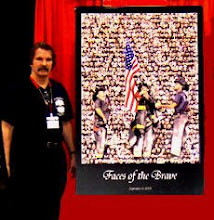Security Concerns Raised About Memorial at Ground Zero
Lower Manhattan Development Corporation
The memorial plaza at ground zero, in an artist's rendering. A security official, James K. Kallstrom, raised concerns in a confidential letter last month about the vulnerability of the planned memorial complex.
By DAVID W. DUNLAP
Published: April 21, 2006
Gov. George E. Pataki's senior adviser for counterterrorism has concluded that the design for the memorial at ground zero leaves it vulnerable to a terrorist attack and has called on the architects to consider revising several critical aspects.
Calling the 9/11 memorial a potentially attractive target, the adviser, James K. Kallstrom, expressed concern in a recent letter about the threat of bombs or a chemical release on the ramps or in the two immense open-air voids at the heart of the memorial. Thousands of people are expected to gather every day within the tower footprints.
Mr. Kallstrom's findings were laid out in a confidential letter to the Lower Manhattan Development Corporation, dated March 3. A copy of the six-page letter was mailed anonymously to The New York Times and received this week. There was no way to assess the sender's motives.
"The memorial complex possesses an elevated level of risk and target attractiveness, as a result of its international stature and large public assembly capacity," Mr. Kallstrom wrote.
Noting the value of a design that "encourages and engenders public interaction," he added that it was "these very elements, which constitute vulnerabilities from a security perspective, which are not adequately addressed in the current design documents."
In an interview yesterday, Mr. Kallstrom, a former assistant director of the F.B.I., expressed displeasure that the letter had been disclosed, declined to elaborate on the specific design suggestions and said they "were not formal recommendations but reflective of the thinking by the security team of where the recommendations could end up."
Much discussion lies ahead about their merits, complexity and cost. The budget for the memorial and memorial museum officially stands at $490 million but is likely to go up in the next few weeks when the construction manager completes its own assessment.
Mr. Kallstrom's letter could present a new hurdle in the repeatedly delayed and politically volatile effort to redevelop the site of the World Trade Center.
Indeed, the letter raises fundamental questions: Can the public be protected without creating a formidable, bunker-like atmosphere? Are the suggested changes consistent with a memorial intended to be open and permeable, knitting ground zero back into the city's fabric?
Mr. Kallstrom has not proposed undoing the basic concept of a tree-filled plaza punctuated by two voids. "I don't anticipate any major design changes," he said in the interview. "We're not looking to put a fence around the plaza or close it down. The beauty and spirit and heart of it can be maintained."
This is not the first time that safety and design concerns have collided at the site. Last year, in response to the New York Police Department's security concerns, the plan for the Freedom Tower was radically revised, yielding a structure with an almost windowless, 200-foot-high concrete base. But a security-inspired redesign of the World Trade Center PATH terminal preserved the openness of its glass-filled main hall.
In the case of the memorial, it seems almost inevitable that some changes, if they were to be put in place, would sharply affect a visitor's experience. As many as 2,000 visitors at a time might be gathered in the open-air galleries, 27 feet below street level, around the pools at the base of the voids. Dozens more would be on the open-air ramps.
In the letter, Mr. Kallstrom asked that the memorial designers consider the use of "secure-access portals, which would create a set number of dedicated pathways by which pedestrians can access the area of the plaza containing the void openings and ramp entry zones."
He also urged that the number of people on the ramps be kept as low as possible and suggested that the designers look into partitioning the ramps "to segregate exiting and entering personnel" and make evacuation, rescue and recovery easier.
Around the voids, he suggested "architectural design elements that significantly reduce the opportunity for a satchel charge explosive or airborne contaminant dissemination device to be cast, or a suicide attempt to be made into the void."
Mr. Kallstrom asked the architects to explore means of segregating "an airborne contaminant event within the ramp" and "segregating below-grade occupancies from plaza-accessible areas when security conditions so dictate."
While he said he did not foresee moving the screening station from its current planned location, at a switch-back midway along the entry ramp, he said it should probably be enlarged to allow room for more thorough searches and an area for detaining people.
Mr. Kallstrom said he was writing on behalf of the Lower Manhattan Counter-Terrorism Advisory Team, a multiagency group that includes the Police Department, and its private security consultants, Science Applications International Corporation. He also said the firm Ducibella Venter & Santore helped identify areas of vulnerability.
Although the letter repeatedly uses the phrase "L.M.C.A.T.'s recommendation," Mr. Kallstrom said yesterday that it was intended more as a heads-up to the architects and engineers about possible security considerations. Bids from contractors for the memorial's structural foundations are due next month.
"My concern is that we didn't have to go back and jackhammer things out," Mr. Kallstrom said.
The letter was addressed to Stefan Pryor, president of the Lower Manhattan Development Corporation, with a copy to John P. Cahill, secretary to the governor. It was distributed on April 5 to senior executives of the World Trade Center Memorial Foundation, which will build and operate the memorial.
It is striking for its explicit references to terrorist threats. Officials are typically much more circumspect in public remarks. Mr. Kallstrom would clearly have preferred to keep it that way. "I'm going to recommend that we have an investigation to see who disclosed it," he said.


0 Comments:
Post a Comment
<< Home